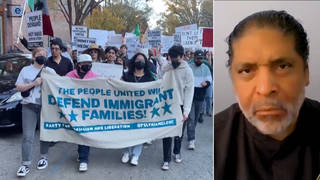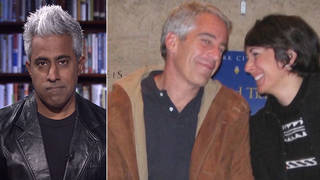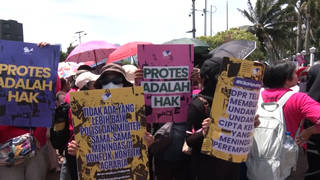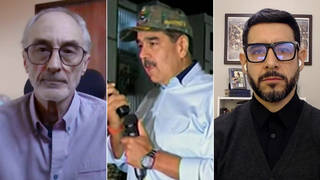
Topics
This weekend marked the 15th anniversary of the massacre at the Santa Cruz cemetery in East Timor. On November 12, 1991, Indonesian troops opened fire on a crowd of several thousand unarmed Timorese civilians gathered in Dili. At least 271 people were killed. Journalists Amy Goodman and Allan Nairn witnessed and survived the massacre. We play an excerpt of their award-winning documentary, “Massacre: The Story of East Timor.” [includes rush transcript]
- “Massacre: the Story of East Timor”
WATCH: Stream [ 64Kb || 256Kb] Download: [ 68MB || 154MB]
LISTEN: Stream [ Lo || Hi] Download: [ 14MB || 28MB]
For further information on the massacre, see etan.org
Transcript
AMY GOODMAN: This is Democracy Now!, democracynow.org. From genocides current to genocides past, this weekend marked the 15th anniversary of the massacre at the Santa Cruz cemetery in East Timor. On November 12, 1991, Indonesian troops, armed with U.S. M-16s, fired on a crowd of several thousand unarmed East Timorese civilians gathered at the Santa Cruz cemetery in Dili, East Timor. At least 270 Timorese were killed. As they sought medical treatment in hospitals, even with that, more than 270 people killed. The massacre was a turning point in Timor’s struggle for self-determination after decades of Indonesia’s brutal occupation. At least a third of the population was killed, 200,000 people displaced or killed between 1975 and 1999, when Indonesia illegally invaded Timor.
I was in East Timor 15 years ago this weekend with journalist Allan Nairn, and this is a clip of our documentary, Massacre: The Story of East Timor.
AMY GOODMAN: And then came the morning of November 12, the two-week commemoration of Sebastiao’s funeral. A memorial mass and procession were planned to lay flowers on Sebastiao’s grave. After the mass was held at the Moteal, people, young and old, came out into the street, and in a land where public speech and assembly had been forbidden for over a decade, they started chanting. The Timorese then held up banners drawn on bed sheets. They had been prepared for the delegation that never came. The banners called on Indonesia to leave East Timor and said things like “Why the Indonesian army shoot our church?” The Timorese were facing a gauntlet of troops that stretched the length of Dili. It was the boldest act of public protest occupied Timor had ever seen.
ALLAN NAIRN: More and more Timorese joined the procession. They came from huts and schools and offices along the way. And there was this building feeling of exhilaration, as well as fear, among the Timorese. And when they reached the cemetery, the crowd had swelled to maybe 5,000 people. Some went inside to lay flowers on Sebastiao’s grave. Most of the crowd was still outside, and then suddenly, someone looked up, and we saw that marching up along the same route that the Timorese had come came a long column of Indonesian troops, dressed in brown, holding M-16s in front of them, marching in a very slow, deliberate fashion — hundreds and hundreds of troops, coming straight at the Timorese.
AMY GOODMAN: Allan suggested we walk to the front of the crowd between the soldiers and the Timorese, because although we knew that the army had committed many massacres, we hoped that we, as foreign journalists, could serve as a shield for the Timorese. Standing with headphones on and microphone and camera out in full view, we went and stood in the middle of the road, looking straight at the approaching troops. Behind us, the crowd was hushed as some Timorese tried to turn away, but they were hemmed in by cemetery walls.
ALLAN NAIRN: The soldiers marched straight up to us. They never broke their stride. We were enveloped by the troops, and when they got a few yards past us, within a dozen yards of the Timorese, they raised their rifles to their shoulders all at once, and they opened fire. The Timorese, in an instant, were down, just torn apart by the bullets. The street was covered with bodies, covered with blood. And the soldiers just kept on coming. They poured in, one rank after another. They leaped over the bodies of those who were down. They were aiming and shooting people in the back. I could see their limbs being torn, their bodies exploding. There was blood spurting out into the air. The pop of the bullets, everywhere. And it was very organized, very systematic. The soldiers did not stop. They just kept on shooting until no one was left standing.
AMY GOODMAN: A group of soldiers grabbed my microphone and threw me to the ground, kicking and punching me. At that point, Allan threw himself on top of me, protecting me from further injury. The soldiers then used their rifle butts like baseball bats, beating Allan until they fractured his skull. As we sat on the ground, Allan, covered in blood, a group of soldiers lined up and pointed their M-16s at our heads. They had stripped us of all of our equipment. We just kept shouting, “We’re from America!” In the end, they decided not to execute us.
ALLAN NAIRN: The soldiers beat us, but we actually had received privileged treatment. We were still alive. They kept on firing into the Timorese. We were able to get onto a passing civilian truck, went into hiding, but the Timorese, who had been with us there on the cemetery road, most of them were dead.
AMY GOODMAN: Inside the cemetery walls, Max Stahl, a filmmaker on assignment with Yorkshire TV, had had his video camera running.
MAX STAHL: The soldiers began at that point to encircle the entire cemetery. I saw the soldiers as they gradually moved towards the middle, picking out people who were wounded or taking refuge between the tombstones, and when they got to them, they beat them and assembled them in the back of the cemetery. People were stripped to their waists. They had their thumbs tied behind their backs, and they were made to look at the ground. And if they looked up, they were immediately beaten, usually with a rifle butt.
AMY GOODMAN: Max Stahl was filming near a crypt in the middle of the cemetery. Some of the wounded and those too scared to run were huddled inside praying. As Stahl filmed, he buried his videocassettes in a fresh grave. Then he was arrested by the troops.
MAX STAHL: Whilst I was being interrogated, I observed these trucks driving by with more people in them. These people were clearly in a kind of paralysis of fear. They were not able to move. Some of them, at least in the cemetery and, indeed, even in the trucks, when I saw them going by, were barely breathing. And people were that terrified. It’s quite often difficult to tell if they’re dead or alive.
AMY GOODMAN: After nine hours in custody, Stahl went back to the cemetery under cover of night, dug up his videocassettes and had them smuggled out of the country. Allan Nairn and I had managed to leave East Timor a few hours after the massacre. From a hospital on Guam, we reported what had happened to dozens of newspapers, radio and television outlets around the world.
PACIFICA REPORT: From Washington, this is the Pacifica report for Tuesday, November 12, 1991. A massacre in East Timor. Among those injured were two journalists, including a news editor of Pacifica station WBAI in New York.
AMY GOODMAN: They beat me and dragged me over and started slamming me with rifle butts, and kicks and punches, and then Allan jumped on top of me, and they beat him very badly. But that was the least of what they did. They opened fire on the people, and these were truly defenseless people —
MONTAGE OF WORLD NEWS FOOTAGE: When Indonesian troops opened fire on a crowd — This is CBC Radio — The massacre of one hundred unarmed Timorese by the Indonesian military — Photographs of the bloody massacre during the fight for freedom — This is the CBS Evening News.
AMY GOODMAN: In the face of the massacre story, even Suharto’s longtime allies were compelled to condemn the killings and came under public pressure to cut back their aid to Indonesia. In Australia, large crowds marched on the Capitol and surrounded Indonesia’s local consulates. The European Parliament voted for sanctions against Indonesia, and the European Community later canceled a scheduled trade pact. There were even opened protests inside Indonesia, where student demonstrators were beaten and arrested. Back in the United States, the Bush administration continued to ship weapons to Indonesia.
PRESS SECRETARY: Ladies and gentlemen, the president of the United States.
AMY GOODMAN: The only time President Bush mentioned East Timor publicly was months after the massacre, when asked about it by a Portuguese journalist.
PRESIDENT GEORGE H.W. BUSH: A lot of discussion is going on, on the tragedy in East Timor. We have expressed ourself in terms of the pure human rights part of it. We pride ourselves, and I think properly so, on standing up for human rights, and I think we’ve made clear to the parties that are interested there the U.S. position. I don’t know how it will come out, frankly.
AMY GOODMAN: That position: to call for an increase in U.S. military training aid. It’s called IMET, International Military Education and Training. More than 2,600 Indonesian officers have been trained under IMET since 1975. They include those who planned the invasion and have overseen the policy of mass slaughter.
Immediately after the massacre, General Try Soetrisno, the national commander of the Indonesian armed forces, gave a speech to a military gathering. He said of the Timorese who dared to oppose the Indonesian armed forces, “They must be shot,” adding “and we will shoot them.”
Listening to politicians is something Jose Ramos-Horta has been doing for 17 years. He left East Timor at the age of 25, just before Indonesia invaded. He had been sent to the United Nations to plead East Timor’s case. While Ramos-Horta got out of East Timor alive, much of his family has been killed.
JOSE RAMOS-HORTA: I lost one sister and two brothers. The sister, she was 17 when she was killed along with 20 other kids. Two Bronco aircraft nosedive over a village and blew up the school and 20 kids there. One brother was killed when he was captured. Another, we don’t know what exactly happened, but he disappeared during a helicopter assault on my village, where he was.
But like me, there are many, many other families, and, in fact, some are even worse. I know families that were totally wiped out, families that I knew, I grew up with, that no longer exist. I know villages, when all my youth I spent there, and when I ask survivors, I’m told that village does no longer exist. It’s not on the map.
So, this is the scale of the tragedy that was imposed on East Timor with U.S.A. complicity.
AMY GOODMAN: How do you hold out hope? You have been outside the country for 17 years. You have been the representative of East Timor at the United Nations for more than a decade. What gives you any hope?
JOSE RAMOS-HORTA: Well, the past 17 years that I have been engaging in diplomatic struggle, I also have witnessed, and all of us witnessed, empires crumbling. No one thought possible five years ago, ten years ago, that the Soviet Union would disintegrate into independent states or Yugoslavia or the Berlin Wall, democratization in Africa and elsewhere. And Indonesia will follow the same. It is — it cannot escape the train of democracy. But apart from that, the resistance in East Timor continues at all levels: armed resistance, one, but also cultural, religious — the entire people are mobilized. And we are very confident. I can state categorically, in the next three, five years, six years, maybe a bit longer, East Timor is going to be independent.
AMY GOODMAN: An excerpt of the documentary, Massacre: The Story of East Timor.












Media Options